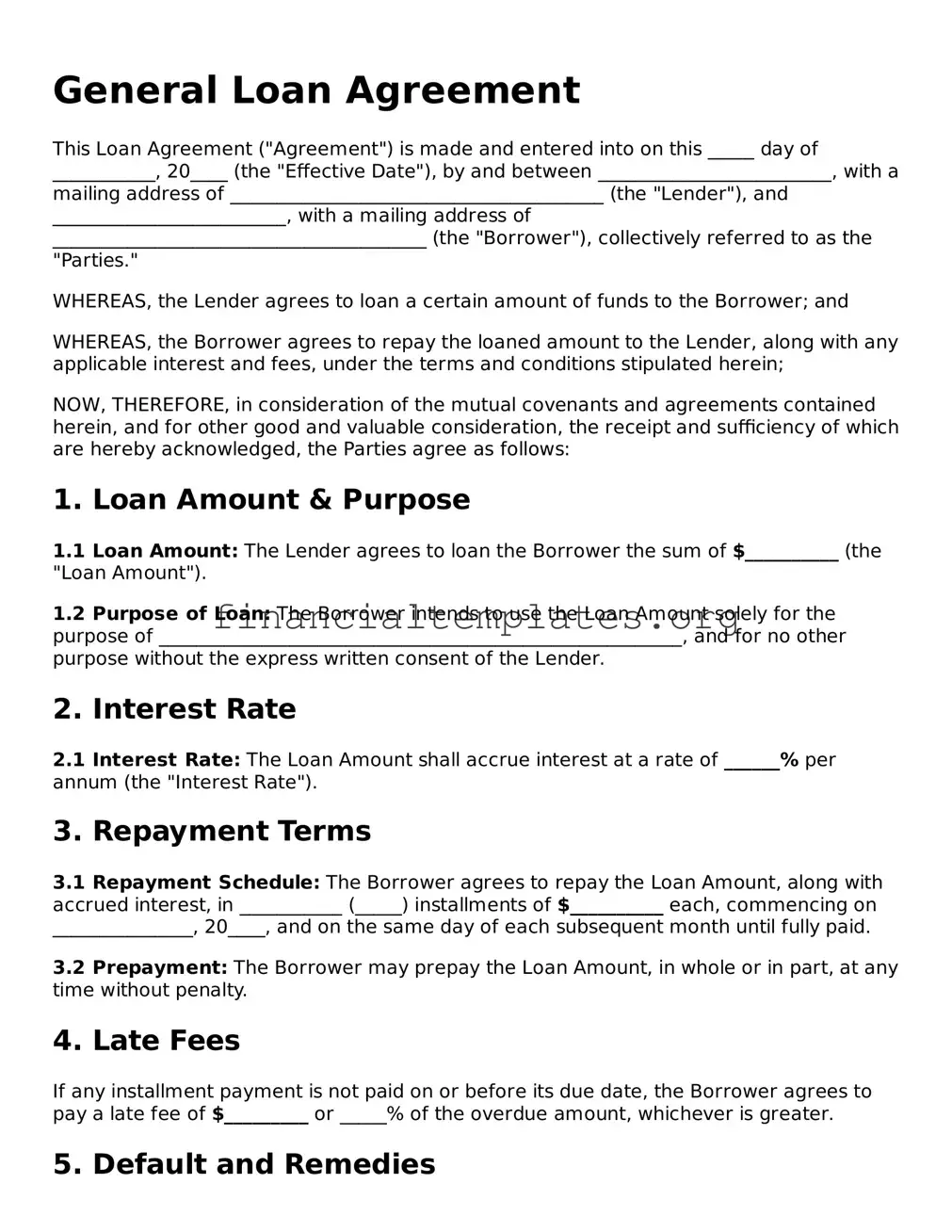General Loan Agreement
This Loan Agreement ("Agreement") is made and entered into on this _____ day of ___________, 20____ (the "Effective Date"), by and between _________________________, with a mailing address of ________________________________________ (the "Lender"), and _________________________, with a mailing address of ________________________________________ (the "Borrower"), collectively referred to as the "Parties."
WHEREAS, the Lender agrees to loan a certain amount of funds to the Borrower; and
WHEREAS, the Borrower agrees to repay the loaned amount to the Lender, along with any applicable interest and fees, under the terms and conditions stipulated herein;
NOW, THEREFORE, in consideration of the mutual covenants and agreements contained herein, and for other good and valuable consideration, the receipt and sufficiency of which are hereby acknowledged, the Parties agree as follows:
1. Loan Amount & Purpose
1.1 Loan Amount: The Lender agrees to loan the Borrower the sum of $__________ (the "Loan Amount").
1.2 Purpose of Loan: The Borrower intends to use the Loan Amount solely for the purpose of ________________________________________________________, and for no other purpose without the express written consent of the Lender.
2. Interest Rate
2.1 Interest Rate: The Loan Amount shall accrue interest at a rate of ______% per annum (the "Interest Rate").
3. Repayment Terms
3.1 Repayment Schedule: The Borrower agrees to repay the Loan Amount, along with accrued interest, in ___________ (_____) installments of $__________ each, commencing on _______________, 20____, and on the same day of each subsequent month until fully paid.
3.2 Prepayment: The Borrower may prepay the Loan Amount, in whole or in part, at any time without penalty.
4. Late Fees
If any installment payment is not paid on or before its due date, the Borrower agrees to pay a late fee of $_________ or _____% of the overdue amount, whichever is greater.
5. Default and Remedies
In the event of a default by the Borrower under the terms of this Agreement, the Lender shall have the option to declare the entire outstanding balance immediately due and payable and may pursue any remedies available under applicable law.
6. Governing Law
This Agreement shall be governed by the laws of the State of _______________, without regard to its conflict of laws principles.
7. Amendment
This Agreement may only be amended or modified by a written document duly signed by both Parties.
8. Notices
All notices under this Agreement shall be sent to the addressed Parties at their respective addresses set forth above, or to such other address as either Party may from time to time specify in writing.
9. Entire Agreement
This Agreement constitutes the entire agreement between the Parties pertaining to the subject matter hereof and supersedes all prior agreements, understandings, negotiations, and discussions, whether oral or written, of the Parties.
10. Signatures
The Parties hereby signify their agreement to the terms above by their signatures below:
______________________________________
Lender: ________________________________
Date: __________________________________
______________________________________
Borrower: ______________________________
Date: __________________________________
